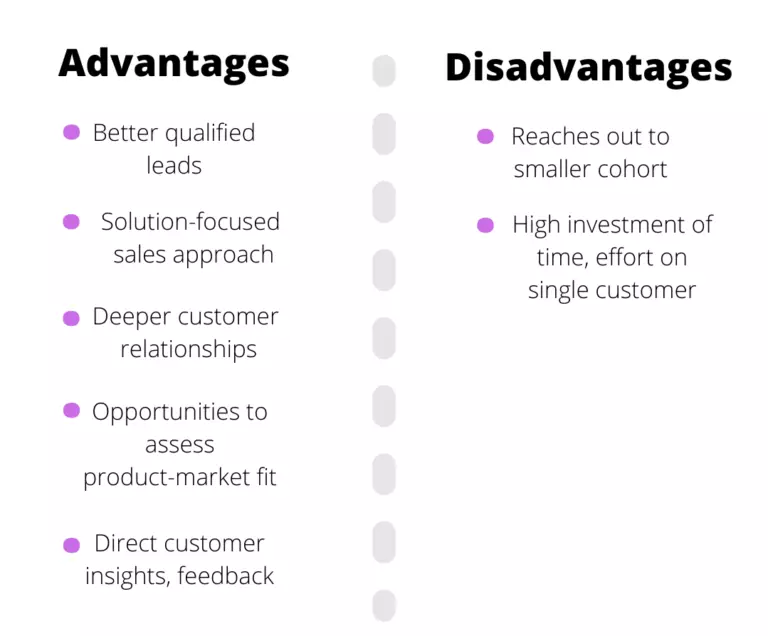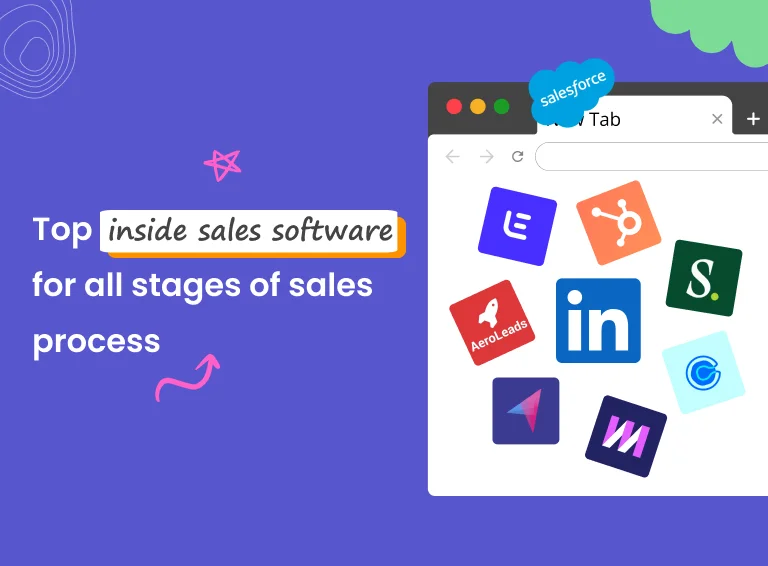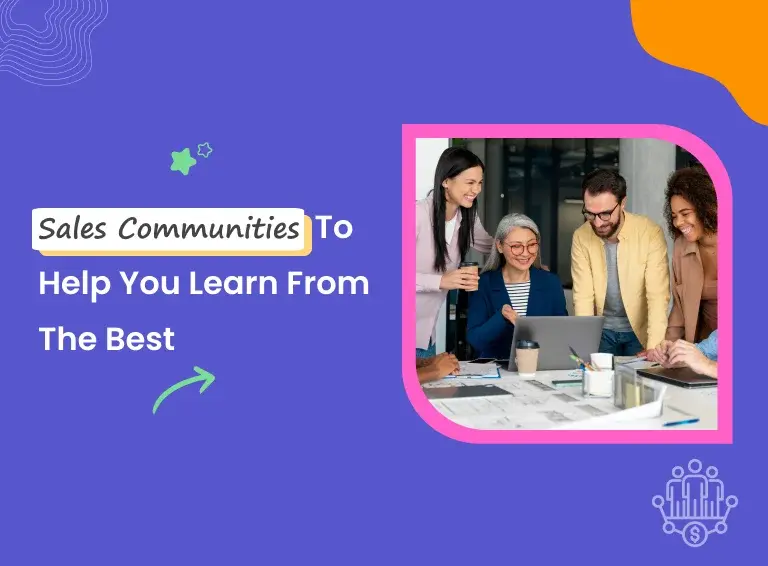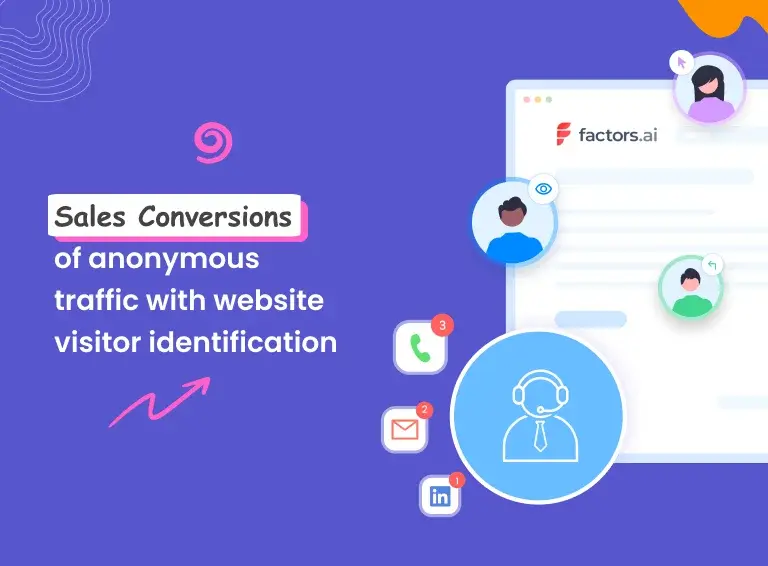People, prospecting, wooing, conversations, missed signals, mixed signals, rejection, heartbreak, and that heady feeling when things go well.
If you think about it, sales can be a lot like dating.
What then makes a good dating story or a good sales one?
The personal element.
The most fondly remembered dating experiences are those that made us feel interesting, heard, and understood. Personal selling is a sales technique that ensures customers feel the same way about their buying experiences.
What Is Personal Selling?
Personal selling is a sales technique where a sales rep meets the prospect face-to-face, understands their problems and provides the best suited solution for their problems.
It places the focus on the unique needs, challenges, and wants of a prospective customer, and not on the flashy new product — or the bells and whistles it comes with. When you adopt personal selling, you take a step back and ask - Does my prospect really need this product or am I desperate for a sale here?
Personal Selling Is the Answer to the Current State of Sales
Now is said to be the age of the buyer, where prospective customers are educating themselves about the product and making decisions on their own, it is time for salespeople to take a step back and look at how they are selling. G2.com reports that vendor trust in salespeople is waning owing to pushy sales tactics peddled out in the last decade.
The report revealed, “They (buyers) have more control of the software purchasing journey than ever, as they increasingly embrace self-serve channels and lean into the experts, peers, and communities they trust to guide their buying decisions. For software sellers, this means they'll need to get smarter about how they engage their audience — meeting them on the channels they prefer, reducing friction to try and buy, and helping them realize immediate value post-purchase."
This is why there’s no better time to sell face-to-face and by building trust with the prospect.So instead of taking a metaphorical megaphone to talk about your product/service to anyone within earshot, personal selling offers salespersons a strategy focused on careful consideration and purposeful listening to deliver value to your customers.
Advantages and Disadvantages of Personal Selling
Okay, so personal selling is great. If it was so great why did other sales strategies take over? Below we unpack what makes personal selling relevant today and why some may consider it obsolete.
Advantages of Personal Selling
- You have better-qualified leads - Personal selling is a huge investment of time and effort. Agreed. But, since you have focused on uncovering their deepest needs and have been honest with them, you are more likely to separate the wheat from the chaff early on in the sales process. By adopting the personal selling strategy, rest assured that your pipeline will only be filled by highly qualified prospects.
- Deeper customer relationships - When you follow a solution-focused approach where you first analyze your prospect's business challenges to give a logical solution, you gain their trust. It gives potential customers the confidence to open up and ask their queries without worrying about you cornering them for a sale. The more trustworthy relationship you have with them, the better your chance of closing them when the time's right.
- Opportunities to assess product market fit - Personal selling allows you to assess product market fit in real time. When you talk to prospects and customers regularly, you'll have a better idea about your ideal customer profile's changing needs and requirements. You can use this information to make timely additions or enhancements to your product.
- Direct customer feedback or insights - As personal selling happens face-to-face, you can easily gauge prospects' interest through their verbal and non-verbal cues.This allows you to improvise your sales strategy mid-way if prospects sound uninterested. It’s easier to identify any uncertainties and nip them in the bud early on.
Disadvantages of Personal Selling
- High investment of time and effort on a single customer - Your prospects won’t confide in you about their problems the moment you connect. You should first gain their trust and then coax them to talk about their business needs and challenges. This requires you to invest a considerable amount of time and effort on each prospect irrespective of whether they convert or not. So, it’s not recommended for businesses that are growing quickly or sell at volume or have a low-priced solution.
- Reaches out to smaller cohorts - Since personal selling demands a high investment of time and resources, the number of prospects you can reach out to is limited, unlike mass outreach techniques.

The Personal Selling Process
Personal selling is a selection of six steps, each one of which allows a salesperson to better understand prospects’ problems and provide better-suited solutions — ultimately leading to higher close rates.
1. Prospecting
The first step in personal selling is picking out prospects who match your ideal customer profile, not those who just showed an interest. For instance, if you sell a CRM software, your Ideal Customer Profile would be a marketing or a sales head, or a business development manager. Additionally, you’d need to figure out which channels (Email, Call, LinkedIn or SMS) would work best, what’s the message that will help engage them, etc. So, if you see, say a software developer or an office administrator, signing up for a demo of your product, you’d need to either reject the lead or research deeper to understand if they could lead you to the user who matches your ideal customer profile.
Here is the information you need to have at the end of your prospecting efforts:
- The lead’s designation
- Contact information
- The size of the company, team
- Their industry
- Industry-specific problems
- A pain point, specific to their role
- Additional details, such as the current tool they’re using, is their current tool due for expiry, etc. You can use buyer intelligence tools like 6sense or Builtwith to understand this.
2. Approaching Prospects
The ultimate goal of this stage is to understand the prospect, their problems, needs, and wants, to build on what you already discovered during the prospecting stage. This information will help you personalize your approach and narrow down the channel (email or call or LinkedIn) to use to reach them.
In your approach, use the Personalization-Benefit-Request formula.
- Personalization: Use your research to find a personal connection you can lead with — be it an article they wrote, or an event they attended or organized. Personalize your email conversation by adding a video or using an engaging subject line. We’ve put together a handy list of ways you can personalize your sales emails.
- Benefits: Show them a picture of the end, instead of focusing on product features or pricing at this stage.
- Request: As tempting as it can be, it might be better to ask for their time at a later stage. Instead, it could be a simple question to start a conversation.
The key to approaching your prospects is to have an effective sales engagement playbook. Choose the right channel to reach out on, the scale at which you want to reach out, the number of follow-ups for each prospect, and the depth of personalization in the communication, and then identify a sales engagement tool that fits your sales team’s particular needs.
Using a sales engagement software, you can reach out to hundreds of prospects, over email, call or LinkedIn with highly personalized messages (to some extent) and enjoy high conversions.
💡 There are intent-based sales engagement tools that you can use to target and foster relationships with critical prospects. Check out Klenty, if you’re intrigued by this outreach strategy.
3. Presenting or Demonstrating Product
Now’s the time to put your research to the test and understand a) if the problems and pain points you discovered through your research are valid and b) the degree to which they impact your prospects. Make sure the thoroughness of your earlier research and your interest to help them shine through through you in-person sales presentation or online sales pitch.
At this stage, you have to understand what exactly they’re going through so you can frame your offering as a solution to their problems. Here are a few questions you can ask to get the most out of your conversation:
- What parts of their current process do they struggle the most with?
- What specific problems or pain points do they observe?
- Are there any specific features/functions they are looking for?
- What does their budget look like?
- What does their buying timeline look like: Is this an urgent purchase or one for later down the line?
You can use a lead qualification process like BANT or MEDDIC to extract information that you can use to close the deal. If you’re looking for a comprehensive way to qualify your prospects, check out our guide to lead qualification.
During the demo, you can rope in a specialist to introduce the product and highlight features that solve their high-priority problems first, instead of just showcasing what your product is good at.
Pro Tip: If there’s one big difference between a real date and a sales date, it’s this: On sales dates, talking about your previous experiences may actually be a great idea. Weave in stories with examples of how other customers — preferably from their industry or circle — have benefitted from your solution.
Now’s also a good time to probe and understand the next steps at their end so you know their preferred timelines and modes for following up.
4. Handling Objections
Sales representatives are all too familiar with this stage, but it’s important to remember that the goal of this step is not to force them into a purchase but to make that decision easier for them. Here’s where the FAQs, references, and sales qualification process you prepared earlier can help you.
Here’s how to handle the 4 most common sales objections using the personal selling approach:
When they decided to go for your competitor’s product
Find out which product they are going for. Since you’ve already scanned the competitive landscape and know the shortcomings of your competitors, and the needs of your prospect, you can remind them of their problems and wonder out loud how they’re going to solve a problem with the competitor’s product.
Ask:
“Alright. So how would you be solving *problem X* with *Competitor’s product*? Because I remember you saying earlier that solving this problem was a priority.”
When they are unaware of the value of your product
The objection you may hear is, “We still cannot see how this will help with our bottom line.”
It’s as simple as showing them the math. Again. Show them what they’re missing out on. Tell the right person that they’d be passing on a huge economic benefit if they get your product.
But before you go about explaining your product’s value, ask them if they’d be interested in listening to it.
When they ghost you
The personal selling approach actually helps you prevent such awkward situations. Establishing a relationship with your prospect during the sales process will encourage two-way communication.
But if you do get ghosted in a worst-case scenario,
- Find out if the deal is worth going after. It is as simple as knowing which deal brings home a higher MRR and following up with that prospect.
- Extend the period you have set for the closure of a deal by one more month (or however long). And structure your follow-ups by content, time, and channel.
Sample script:
*Prospect* completed the demo and has moved on to trial but has not replied since the demo.
Send follow-up emails throughout the duration of the trial with an interval of 2-3 days. All the content should be related to how their trial is going, and if the product is meeting their expectations. Don’t mention the lack of response.
Hi *prospect name*, Last we talked your team was pretty excited about solving *problem X* using *product*. But I haven’t heard from you since the demo, so are you still interested in moving forward with *product* or have you found some other solution?Regards,*Your name*- Always keep your copy short when you’re fishing for a response, because you only need a yes or no response. Shortening it to a one- or two-line email copy will be easier to read and reply to if the probable reason for ghosting is the prospect’s lack of time.
When it’s not the right time
One would naturally ask, “So, when is the right time to get back to you?” or “So, when can we call you back?” or “So, when can we pick this up?”
“This is kind of obvious, no?” But the devil is in the details. We’ll explain.
Those questions will handicap the prospect from choosing a time. Your prospect, just like everyone else, has calendars that are colored VIBGYOR by the markings of endless meetings. So how can anyone, really, find time for a sales call? The prospect will, in all likelihood, ghost you after that question.
So, an efficient way to phrase the question to a timing objection would be, “Can I get back to you in a month?”
It’s a “yes” or a “no” question, so if it’s the latter, they will respond with a revised time. This question will push them to reveal an approximate time of when they’d need the product.
5. Closing the Sale
All the relationship-building you’ve done over the course of the sales process will pay off when you’re closing. You have patiently listened to your prospects, learned about their problems, understood their pains. Offer them your solution only if you’ve concluded that it is the right fit for them.
Empathy, the ability to identify and understand other people’s feelings, remains the cornerstone of true personal selling.
So it’s only apt that you use the empathetic sales closing technique. It’s also an added advantage that using this technique should actually be preferred in the current business climate. That’s because there has been an 87% increased importance of long-term customer relationships, and an 83% increase in the importance of building trust before a sale, as revealed by Salesforce’s state of sales report in 2021. Both these factors can be nurtured only by investigating honestly into your prospect’s problems and pains.
The more understanding and accommodating you are with prospects, the less exploitative and opportunistic they will think you are.
3 Personal Selling Strategies
1. Don't Fake It To Make It
Be natural when around prospects. Talk to them the way you would talk to a friend you respect. In other words, find the sweet spot between casual and formal tone.
Your voice shouldn’t be too loud and imposing either. It should be firm and audible. Be confident in your solution.
2. Coax Prospects To Open Up
Your goal is to build relationships, and the best way here is to give your products and their features a back seat. Now, bring your prospects’ pain points and needs to the spotlight.
Coax them to talk by asking them a lot of questions. Also, use the power of verbal and non-verbal cues to tell them you care and won’t corner them for a sale.
In other words, give them the perfect environment to open up and share their problems.
3. Build Long-term Relationships
You are wrong if you believe a sale is the final step in personal selling. The core idea of personal selling is to promote customer satisfaction.
But all your effort would go down the drain if you don't follow up with your prospects after a sale.
Also according to the G2 buyer behavior report, one of the biggest goals of a buyer during the purchasing process is to see value early in their customer journey. So, don't hesitate to reach out to them, ask them how they are finding your product, and suggest ways to leverage the product in the best way possible. Many customer-focused teams use lightweight tools to streamline this follow-up—like sending post-sale how-to videos, dynamic feedback forms, or quick re-engagement links. For example, Uniqode's Dynamic QR Codes allow reps to share personalized content that can be updated in real-time, letting customers revisit onboarding material or share instant feedback. Similarly, tools like Calendly links, Typeform surveys, or short video explainers also help create trust and reduce friction in the early stages.
This way, you will build long-lasting customer relationships and also open new avenues to upsell.
Personal Selling Examples
Personal selling example in Cosmetics Shops- Salespeople in cosmetics shops make use of personal selling. They give advice on brands, methods of product application and even lets potential buyers try their products before buying. Thus, when they patiently walk buyers through the whole process, customers trust them enough to buy from them not once, but regularly.
For Car Dealers- When prospective buyers enter a car showroom, car dealers don’t rush them to pick the first car they see. Instead, dealers first understand their needs like mileage needs, budget, preferred number of seats, must-have features, preferred model, etc. Accordingly, the dealer shows a couple of cars along with an offer for them to test-drive the vehicles. Here, car dealers leverage the personal selling technique to understand buyer needs and give the best options.
For Travel Agents- Travel agents also use the personal selling method. They enquire about customer needs like location, the number of days, the age of the tourists, medications, and special diets they follow, etc. before coming up with suitable packages for customers. Like car dealers, they understand customer needs and try to sell the best package that matches their customers' expectations.
No matter the scenario or setting, the core concept of personal selling boils down to 3 things:
- Gain the trust of prospects through empathy
- Kickstart conversations and nurture relationships but never corner them for a sale right from the start.
- Understand your prospects’ pain points, needs, and challenges and guide them to the best-suited solution – not necessarily your company’s product.
Over to You
The turn of the century has witnessed the rise of groundbreaking technologies, processes, and frameworks, but personal selling remains as it was centuries ago. It has only been slightly adapted to suit the changing buying behavior.
The humanizing element in personal selling has withstood the test of time.
So, as we drown ourselves in technology to sell more to more people, remember to add these personal selling tips:
- Prospecting: Match leads to your ideal customer profile
- Approaching prospects: Personalize your messaging to prospects
- Presenting your product: Qualify prospects using frameworks like MEDDIC or BANT
- Closing the sale: Be empathetic while closing the sale. Don’t rush them or use any pushy tactics





